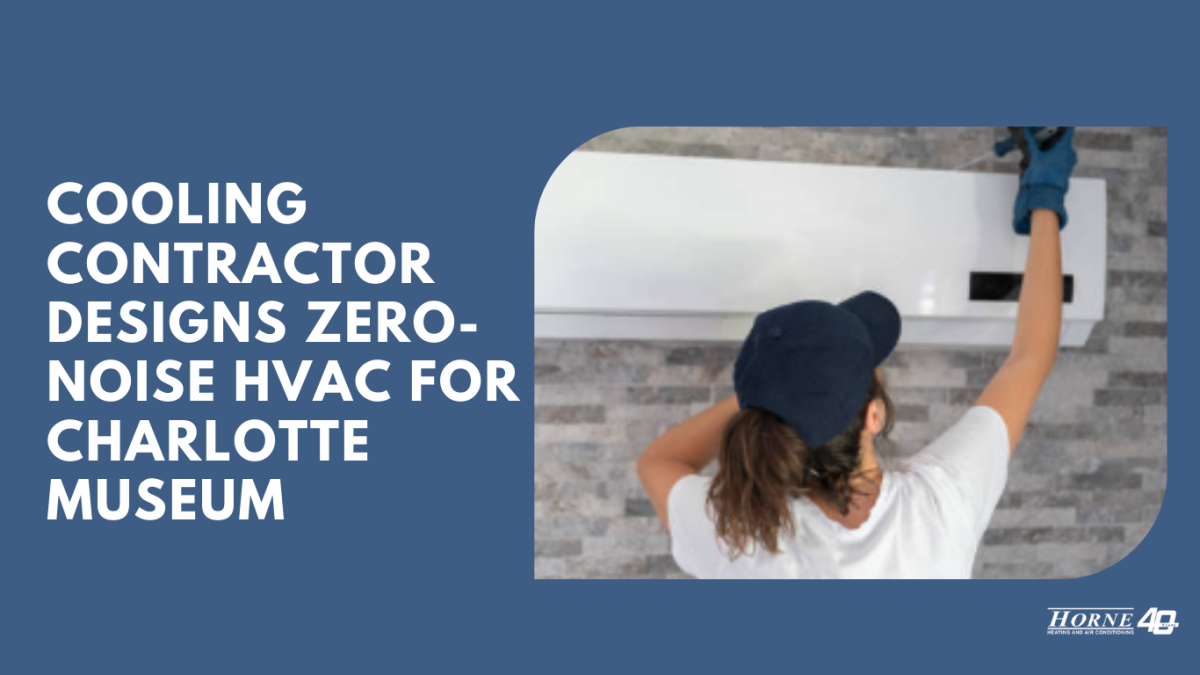How a Charlotte HVAC Expert Helped Keep This Museum Quiet and Cool
Charlotte, United States - May 6, 2025 / Above All Media /
In recent years, the integration of advanced HVAC systems in cultural institutions like museums has become increasingly important. Museums are spaces that house invaluable works of art, rare artifacts, and priceless historical collections.
As these institutions grow and evolve, they face new challenges in providing optimal environmental conditions—balancing temperature, humidity, and air quality—without compromising the experience of their visitors.
One such challenge is maintaining a quiet, serene environment that allows visitors to engage fully with exhibits. To address this, a Charlotte museum has implemented a cutting-edge zero-noise HVAC system, designed specifically to meet the unique needs of the space.
How Does a Zero-Noise HVAC System Work in a Museum Setting?
A zero-noise HVAC system is designed to maintain the necessary environmental conditions within a museum without the typical sounds associated with traditional heating, ventilation, and air conditioning systems. Here’s how such a system works in a museum setting:
- Noise-Reducing Technologies: The core principle behind a zero-noise HVAC system lies in the incorporation of advanced noise-reduction technologies. These systems are built with noise-dampening components such as specialized ductwork, acoustic insulation, and vibration-isolating materials. By isolating sound-producing elements, such as fans and motors, from the rest of the system, the HVAC’s noise output is significantly minimized.
- Precision Temperature and Humidity Control: Museums require a consistent and precise control of temperature and humidity to protect their exhibits. Traditional HVAC systems often make noise as they cycle on and off, creating unwanted disruptions. A zero-noise system, however, utilizes advanced sensors and intelligent control mechanisms to maintain steady environmental conditions, ensuring the system operates smoothly without creating noticeable fluctuations or sound.
- Location and Discreet Installation: In a museum, it’s important that HVAC systems remain hidden from view to preserve the aesthetic integrity of the space. A zero-noise HVAC system is often discreetly integrated into the building’s architecture, with air vents and ducts positioned in inconspicuous locations. This ensures that visitors can enjoy the museum experience without the distraction of visible equipment or sounds from the system.
- Silent Fans and Airflow Design: Traditional HVAC systems often rely on high-powered fans to push air through ducts. These fans can create noise as they work, disrupting the quiet atmosphere of the museum. Zero-noise HVAC systems use specially designed fans that operate at lower speeds and with minimal vibration. Additionally, the airflow design is optimized to reduce turbulence and friction, further minimizing noise levels.
- Continuous Air Circulation: One of the most important elements of a zero-noise HVAC system is its ability to provide continuous air circulation without abrupt temperature changes or sudden fan starts. This constant and smooth airflow prevents drafts while keeping the space’s air quality at optimal levels without producing the characteristic hum of traditional systems.
Why is Noise Reduction Important For HVAC Systems in Museums?
Noise reduction plays a critical role in the operation of HVAC systems in museums for several reasons:
- Preserving the Visitor Experience: Museums are spaces designed to engage visitors with their exhibits and collections. The presence of ambient noise from an HVAC system can significantly disrupt this experience. The subtle sounds produced by HVAC systems—like the hum of motors or air moving through ducts—can draw attention away from the artwork and distract visitors. A zero-noise HVAC system eliminates this problem, allowing visitors to focus entirely on the exhibits without external distractions.
- Protecting Sensitive Artifacts: Many of the artifacts housed in museums are sensitive to environmental fluctuations. Heat, moisture, and air quality must be meticulously controlled to preserve the integrity of the collections. An overly noisy HVAC system, due to its increased operational volume, may lead to less efficient performance or cause fluctuations in air temperature or humidity. With a zero-noise system, museums can ensure that these delicate objects are kept in optimal conditions without the risk of exposure to erratic environmental changes.
- Creating a Calming Atmosphere: Museums often strive to create a peaceful, calming atmosphere for visitors. The experience of walking through a quiet, contemplative space allows individuals to fully absorb the art and history surrounding them. Excessive noise from HVAC systems, especially in areas with many visitors, can detract from this atmosphere. By eliminating HVAC-related noise, museums can provide a serene setting conducive to reflection and enjoyment.
- Enhancing Acoustic Control: Many museums host events, lectures, and guided tours, where clear audio and acoustics are essential. The sound of a noisy HVAC system can interfere with speech and audio systems, making it harder for visitors to hear presentations or engage with the exhibit’s content. A quiet HVAC system ensures that the space’s acoustics are undisturbed, providing a better experience for all.
What are the Benefits of Custom HVAC Designs For Cultural Institutions?
Custom HVAC designs for cultural institutions, such as museums, offer numerous advantages that go far beyond typical commercial heating and cooling systems. These benefits include:
- Tailored Solutions for Unique Needs: Museums, galleries, and other cultural institutions often have specific requirements for climate control. Custom HVAC systems allow designers to account for factors such as the size and layout of the space, the types of exhibits, and the volume of visitors. Custom systems are tailored to ensure the temperature, humidity, and airflow are maintained at optimal levels, preventing damage to priceless artifacts while also improving the visitor experience.
- Energy Efficiency: Custom HVAC systems are designed with energy efficiency in mind. Museums are large buildings that require significant energy to maintain climate control, and energy consumption can add up quickly. A custom-designed HVAC system is engineered to provide the necessary conditions while reducing energy usage through optimized designs and energy-efficient components. This not only lowers operating costs but also helps museums become more sustainable and environmentally responsible.
- Improved Air Quality: Museums house valuable artwork and delicate materials that can be affected by pollutants in the air. Custom HVAC systems can include advanced filtration systems that improve air quality by removing dust, allergens, and other contaminants from the air. This ensures that both visitors and exhibits are exposed to clean, healthy air, reducing the risk of damage to artifacts while enhancing the comfort of those in the space.
- Long-Term Cost Savings: Although custom HVAC designs may come with a higher initial installation cost, they often result in significant long-term savings. With more efficient operations, fewer maintenance issues, and reduced energy consumption, museums can lower their ongoing expenses. Additionally, by preserving the integrity of their collections and offering a more pleasant visitor experience, custom HVAC systems contribute to the long-term success and sustainability of the institution.
- Adaptability for Future Needs: As museums grow and expand their collections or facilities, their HVAC needs may change. Custom HVAC systems can be designed with flexibility in mind, allowing for future upgrades or modifications as the museum’s needs evolve. This adaptability ensures that the system remains functional and efficient as the institution continues to grow and innovate.
Who Designed the Silent HVAC System For the Charlotte Museum?
The design of the zero-noise HVAC system for the Charlotte museum was carried out by a leading HVAC contractor specializing in custom solutions for cultural institutions. This contractor has extensive experience in working with museums, art galleries, and other buildings that require high levels of environmental control and low levels of noise.
- Expertise in Museum HVAC Systems: The contractor’s team brought years of expertise in designing HVAC systems that meet the specific needs of museums. They understand the delicate balance required between maintaining a stable environment for exhibits and providing a comfortable, quiet space for visitors. Their knowledge of soundproofing techniques, energy efficiency, and air quality control made them the ideal choice for designing the museum’s zero-noise HVAC system.
- Collaborative Approach: The project team worked closely with the museum’s curators, architects, and engineers to develop a system that would integrate seamlessly with the museum’s existing infrastructure. The team also took into account the museum’s layout and the unique requirements of the exhibits, ensuring that the HVAC system would function silently while providing the necessary climate control for each area of the museum.
- Use of Advanced Technologies: The design team utilized the latest HVAC technologies, including advanced noise-reducing components, silent fans, and smart temperature controls, to create a system that would meet the museum’s needs. Their expertise allowed them to design a system that would be virtually undetectable to visitors, while still providing the best possible environmental conditions for both the artifacts and the visitors.
By integrating these advanced technologies, the contractor successfully created an HVAC system that offers museum-quality climate control without the distracting noise of traditional systems. This system not only supports the museum’s mission to preserve and display art but also enhances the overall experience for every visitor.
The implementation of a zero-noise HVAC system in the Charlotte museum is a groundbreaking development in the world of cultural institution design. With its emphasis on silent operation, custom climate control, and energy efficiency, the system ensures that the museum remains a tranquil and welcoming space for both its exhibits and its visitors.
As more museums adopt these advanced HVAC solutions, we can expect to see even greater improvements in the preservation of art and the overall visitor experience.
Experience Unmatched Comfort with Horne Heating and Air Conditioning Inc.
At Horne Heating and Air Conditioning Inc., we understand the importance of a reliable and efficient HVAC system, whether it’s for your home or business. Our team of experienced professionals is committed to providing top-tier heating, cooling, and indoor air quality solutions tailored to meet your specific needs. Whether you're looking to install a new system, perform routine maintenance, or need a repair, we’ve got you covered.
We take pride in offering prompt, friendly service and solutions that enhance the comfort and energy efficiency of your space. Our focus is not just on getting the job done, but on building lasting relationships with our customers based on trust and quality service.
Don’t let HVAC issues disrupt your day. Call Horne Heating and Air Conditioning Inc. today to schedule your service or get a free estimate. Let us help you stay comfortable all year round with expert HVAC care! Experience the difference of working with a company that puts your needs first.

Contact Information:
Horne Heating and Air Conditioning Inc.
6805 Craig St.
Charlotte, NC 28214
United States
Chris Horne
(704) 321-4173
https://www.hornehvac.com/
Original Source: https://hornehvac.com/media-room


